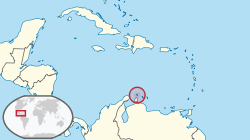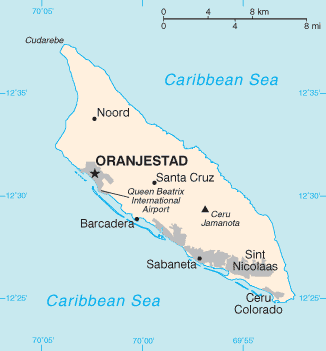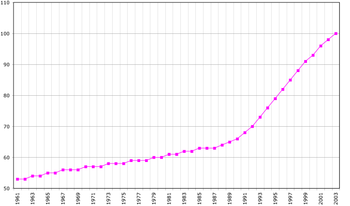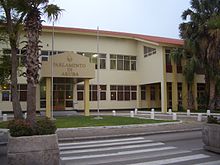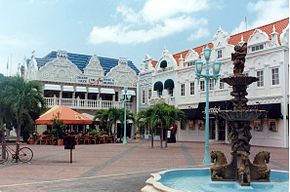
Aruba
Background to the schools Wikipedia
SOS Children offer a complete download of this selection for schools for use on schools intranets. All children available for child sponsorship from SOS Children are looked after in a family home by the charity. Read more...
| Aruba | ||||||
|---|---|---|---|---|---|---|
|
||||||
| Anthem: Aruba Dushi Tera Aruba, Dear Country |
||||||
|
Location of Aruba (circled in red)
in the Caribbean (light yellow) |
||||||
| Capital and largest city |
Oranjestad 12°31′N 70°2′W |
|||||
| Official languages |
|
|||||
| Demonym | Aruban | |||||
| Government | Constitutional monarchy | |||||
| - | Monarch | Willem-Alexander | ||||
| - | Governor | Fredis Refunjol | ||||
| - | Prime Minister | Mike Eman | ||||
| Legislature | Estates of Aruba | |||||
| Autonomy from the Netherlands Antilles | ||||||
| - | Date | 1 January 1986 | ||||
| Area | ||||||
| - | Total | 178.91 km2 69 sq mi |
||||
| - | Water (%) | negligible | ||||
| Population | ||||||
| - | 2010 census | 102,484 | ||||
| - | Density | 567/km2 1,470/sq mi |
||||
| GDP ( PPP) | 2007 estimate | |||||
| - | Total | $2.400 billion ( 182nd) | ||||
| - | Per capita | $23,831 ( 32nd) | ||||
| Currency | Aruban florin ( AWG) |
|||||
| Time zone | AST ( UTC−4) | |||||
| Drives on the | right | |||||
| Calling code | +297 | |||||
| ISO 3166 code | AW | |||||
| Internet TLD | .aw | |||||
Aruba ( / ə ˈ r uː b ə / ə-ROO-bə; Dutch pronunciation: [aˈruba]) is a 33-kilometer-long (20 mi) island of the Lesser Antilles in the southern Caribbean Sea, located 27 km (17 mi) north of the coast of Venezuela. Together with Bonaire and Curaçao, it forms a group referred to as the ABC islands of the Leeward Antilles, the southern island chain of the Lesser Antilles. Collectively, Aruba and the other Dutch islands in the Antilles are commonly referred to as the Netherlands Antilles or the Dutch Antilles.
Furthermore, Aruba is one of the four constituent countries that form the Kingdom of the Netherlands, along with the Netherlands, Curaçao and Sint Maarten. The citizens of these countries all share a single nationality: Dutch. Aruba has no administrative subdivisions, but, for census purposes, is divided into eight regions. Its capital is Oranjestad.
Unlike much of the Caribbean region, Aruba has a dry climate and an arid, cactus-strewn landscape. This climate has helped tourism as visitors to the island can reliably expect warm, sunny weather. It has a land area of 179 square kilometres (69.1 sq mi) and is densely populated, with a total of 101,484 inhabitants at the 2010 Census. It lies outside the hurricane belt.
History
Aruba's first inhabitants are thought to have been Caquetíos Amerinds from the Arawak tribe, who migrated there from Venezuela to escape attacks by the Caribs. Fragments of the earliest known Indian settlements date back to 1000 AD. As sea currents made canoe travel to other Caribbean islands difficult, thus Caquetio culture remained more closely associated with that of mainland South America.
Europeans first learned of Aruba following the explorations for Spain by Amerigo Vespucci and Alonso de Ojeda in the summer of 1499. Though Vespucci boasted of discovering the island, he and Ojeda were likely guided there by natives of nearby islands. Both described Aruba as an "island of giants", remarking on the comparatively large stature of the native Caquetíos compared to Europeans. Ojeda also referred to the island as Oro Hubo, Spanish for "It had gold". Gold was not discovered on Aruba, however, for another 300 years. Vespucci returned to Spain with stocks of cotton and brazilwood from the island and described houses built into the ocean. Vespucci and Ojeda's tales spurred interest in Aruba, and Spaniards soon colonized the island.
Aruba was colonized by Spain for over a century. Simas, the Cacique or chief in Aruba, welcomed the first Catholic priests in Aruba, who gave him a wooden cross as a gift. In 1508, the Spanish Crown appointed Alonso de Ojeda as its first Governor of Aruba, as part of Nueva Andalucía.
Another governor appointed by Spain was Juan Martínez de Ampiés. A cédula real decreed in November 1525 gave Ampíes, factor of Española, the right to repopulate Aruba. In 1528, Ampíes was replaced by a representative of the House of Welser.
The Netherlands have covered the island with their regulations since 1629. Since 1636, Aruba has been under Dutch administration, initially governed by Peter Stuyvesant, later appointed to New Amsterdam (New York City). Stuyvesant was on a special mission in Aruba in November and December 1642. The island was included under the Dutch Dutch West India Company (W.I.C.) administration, as "New Netherland and Curaçao," from 1648 to 1664. In 1667 the Dutch administration appointed an Irishman as "Commandeur" in Aruba.
In August 1806, General Francisco de Miranda and a group of 200 freedom fighters, traveling to liberate Venezuela from Spain, stayed in Aruba for several weeks.
In 1933, Aruba sent its first petition to the Queen seeking independent status and autonomy.
During World War II, Aruba was one of the main suppliers of refined petroleum products to the Allies. During the war, after the German occupation of the Netherlands, Aruba was made a British protectorate from 1940 to 1942, and a US protectorate from 1942 to 1945.
On 16 February 1942, a German submarine ( U-156) under the command of Werner Hartenstein attacked the island's oil processing refinery, but the mission failed.
In March 1944, Eleanor Roosevelt, the First Lady of the United States, briefly visited American troops stationed in Aruba. In attendance were Curaçao Governor P. Kasteel, and U.S. Rear Admiral T. E. Chandler.
Move towards independence
In August 1947, Aruba presented its first Staatsreglement (constitution), for Aruba's status aparte as an autonomous state within the Kingdom of the Netherlands. By 1954, the Charter of the Kingdom of the Netherlands was established, providing a framework for relations between Aruba and the rest of the Kingdom.
In 1972, at a conference in Suriname, Betico Croes (MEP), a politician from Aruba, proposed a sui-generis Dutch Commonwealth of four states: Aruba, the Netherlands, Suriname and the Netherlands Antilles, each to have its own nationality. C. Yarzagaray, a parliamentary member representing the AVP political party, proposed a referendum so that the people of Aruba could choose whether they wanted total independence or Status Aparte as a full autonomous state under the Crown.
Betico Croes worked in Aruba to inform and prepare the people of Aruba for independence. In 1976, he appointed a committee that chose the national flag and anthem, introducing them as symbols of Aruba's sovereignty and independence. He set 1981 as a target date for independence. In March 1977, the first Referendum for Self Determination was held with the support of the United Nations; 82% of the participants voted for independence.
The Island Government of Aruba assigned the Institute of Social Studies in The Hague to prepare a study for independence; it was titled Aruba en Onafhankelijkheid, achtergronden, modaliteiten en mogelijkheden; een rapport in eerste aanleg (Aruba and independence, backgrounds, modalities and opportunities; a preliminary report) (1978). At the conference in The Hague in 1981, Aruba's independence was set for the year 1991.
In March 1983, Aruba reached an official agreement within the Kingdom for its independence, to be developed in a series of steps as the Crown granted increasing autonomy. In August 1985 Aruba drafted a constitution that was unanimously approved. On 1 January 1986, after elections were held for its first parliament, Aruba seceded from the Netherlands Antilles; it officially became a country of the Kingdom of the Netherlands. Full independence was projected in 1996.
After his death in 1986, Croes was proclaimed Libertador di Aruba. At a convention in The Hague in 1990, at the request of Aruba's Prime Minister, the governments of Aruba, the Netherlands, and the Netherlands Antilles postponed indefinitely its transition to full independence. The article scheduling Aruba's complete independence was rescinded in 1995, although the process could be revived after another referendum.
Geography
Aruba is a generally flat, riverless island in the Leeward Antilles island arc of the Lesser Antilles. It is widely known for its white sandy beaches on the western and southern coasts of the island, relatively sheltered from fierce ocean currents. This is where most tourist development has occurred. The northern and eastern coasts, lacking this protection, are considerably more battered by the sea and have been left largely untouched by humans.
The hinterland of the island features some rolling hills, the best known of which are called Hooiberg at 165 meters (541 ft) and Mount Jamanota, the highest on the island at 188 meters (617 ft) above sea level. Oranjestad, the capital, is located at 12°19′N 70°1′W.
To the east of Aruba are Bonaire and Curaçao, two island territories which once formed the southwest part of the Netherlands Antilles. This group of islands is sometimes called the ABC islands.
The Natural Bridge was a large, naturally formed limestone bridge on the island's north shore. It was a popular tourist destination until its collapse in 2005.
Cities and towns
The island, with a population of just over 100,000 inhabitants, does not have major cities.
- Oranjestad (33,000 in 2006)
- Paradera
- San Nicolas
- Noord
- Santa Cruz
- Savaneta
Fauna
The island provides a habitat for the endemic Aruba Island Rattlesnake.
Climate
In the Köppen climate classification, Aruba has a semi-arid climate. Temperature varies little from 28 °C (82.4 °F) to around 33 °C (91 °F), moderated by constant trade winds from the Atlantic Ocean, which comes from north-east. Yearly precipitation barely exceeds 400 mm (15.7 in).
| Climate data for Oranjestad, Aruba (1981–2010, extremes 1951–2010) | |||||||||||||
|---|---|---|---|---|---|---|---|---|---|---|---|---|---|
| Month | Jan | Feb | Mar | Apr | May | Jun | Jul | Aug | Sep | Oct | Nov | Dec | Year |
| Record high °C (°F) | 32.5 (90.5) |
33.0 (91.4) |
33.9 (93) |
34.4 (93.9) |
34.9 (94.8) |
35.2 (95.4) |
35.3 (95.5) |
36.1 (97) |
36.5 (97.7) |
35.4 (95.7) |
35.0 (95) |
34.8 (94.6) |
36.5 (97.7) |
| Average high °C (°F) | 30.0 (86) |
30.4 (86.7) |
30.9 (87.6) |
31.5 (88.7) |
32.0 (89.6) |
32.2 (90) |
32.0 (89.6) |
32.6 (90.7) |
32.7 (90.9) |
32.1 (89.8) |
31.3 (88.3) |
30.4 (86.7) |
31.5 (88.7) |
| Daily mean °C (°F) | 26.7 (80.1) |
26.8 (80.2) |
27.2 (81) |
27.9 (82.2) |
28.5 (83.3) |
28.7 (83.7) |
28.6 (83.5) |
29.1 (84.4) |
29.2 (84.6) |
28.7 (83.7) |
28.1 (82.6) |
27.2 (81) |
28.1 (82.6) |
| Average low °C (°F) | 24.5 (76.1) |
24.7 (76.5) |
25.0 (77) |
25.8 (78.4) |
26.5 (79.7) |
26.7 (80.1) |
26.4 (79.5) |
26.8 (80.2) |
26.9 (80.4) |
26.4 (79.5) |
25.8 (78.4) |
25.0 (77) |
25.9 (78.6) |
| Record low °C (°F) | 21.3 (70.3) |
20.6 (69.1) |
21.4 (70.5) |
21.5 (70.7) |
21.8 (71.2) |
22.7 (72.9) |
21.2 (70.2) |
21.3 (70.3) |
22.1 (71.8) |
21.9 (71.4) |
22.0 (71.6) |
20.5 (68.9) |
20.5 (68.9) |
| Precipitation mm (inches) | 39.3 (1.547) |
20.6 (0.811) |
8.7 (0.343) |
11.6 (0.457) |
16.3 (0.642) |
18.7 (0.736) |
31.7 (1.248) |
25.8 (1.016) |
45.5 (1.791) |
77.8 (3.063) |
94.0 (3.701) |
81.8 (3.22) |
471.8 (18.575) |
| Avg. precipitation days (≥ 1.0 mm) | 8.4 | 5.0 | 1.8 | 1.9 | 2.2 | 2.8 | 4.9 | 4.3 | 3.9 | 7.4 | 10.6 | 11.4 | 64.6 |
| % humidity | 77.5 | 76.1 | 75.7 | 77.1 | 77.9 | 77.4 | 77.8 | 76.2 | 76.8 | 78.6 | 79.1 | 78.4 | 77.4 |
| Source: DEPARTAMENTO METEOROLOGICO ARUBA, (extremes) | |||||||||||||
Demographics
Aruba is situated in the deep southern part of the Caribbean. Because it has low rainfall, Aruba was saved from the plantation system and the economics of the slave trade.
Aruba's population is estimated to be 80% mixed white/Caribbean Amerindian and 20% other ethnicities. Arawaks spoke the "broken Spanish" which their ancestors had learned on Hispaniola. The Dutch took control 135 years after the Spanish, leaving the Arawaks to farm and graze livestock, and used the island as a source of meat for other Dutch possessions in the Caribbean, leading to a depletion of the Arawak population.
The Arawak heritage is stronger on Aruba than on most Caribbean islands. Although no full-blooded Aboriginals remain, the features of the islanders clearly indicate their genetic Arawak heritage. Most of the population is descended mostly from Arawak, and to a lesser extent Spanish, Italian, Dutch, and a few French, Portuguese, British, and African ancestors.
Recently, there has been substantial immigration to the island from neighboring American and Caribbean nations, possibly attracted by the higher paid jobs. In 2007, new immigration laws were introduced to help control the growth of the population by restricting foreign workers to a maximum of three years residency on the island.
Demographically, Aruba has felt the impact of its proximity to Venezuela. Many of Aruba's families are descended from Venezuelan immigrants. There is a seasonal increase of Venezuelans living in second homes.
Language
Language can be seen as an important part of island culture in Aruba. The official languages are Dutch and – since 2003 – Papiamento. Papiamento is the predominant language on Aruba. A creole language spoken on Aruba, Bonaire, and Curaçao, it incorporates words from other languages including Portuguese, West African languages, Dutch, and Spanish. English is known by many; its usage has grown due to tourism. Other common languages spoken based on the size of their community are Portuguese, Chinese, German, Spanish, and French.
In recent years, the government of Aruba has shown an increased interest in acknowledging the cultural and historical importance of its native language. Although spoken Papiamento is fairly similar among the several Papiamento-speaking islands, there is a big difference in written Papiamento. The orthography differs per island and even per group of people. Some are more oriented towards Portuguese and use the equivalent spelling (e.g. "y" instead of "j"), where others are more oriented towards Dutch.
The book The Buccaneers of America, first published in 1678, states through eyewitness account that the Indians on Aruba spoke "Spanish". The oldest government official statement written in Papiamento dates from 1803. Around 12.6% of the population today speaks Spanish.
Aruba has four newspapers published in Papiamento: Diario, Bon Dia, Solo di Pueblo and Awe Mainta; and two in English: Aruba Today and The News. Amigoe is the newspaper published in Dutch. Aruba also has 18 radio stations (two AM and 16 FM) and three local television stations (Tele-Aruba, Aruba Broadcast Company and Channel 22).
Regions
For census purposes, Aruba is divided into eight regions, which have no administrative functions:
| Name | Area (km²) | Population 1991 Census |
Population 2000 Census |
Population 2010 Census |
|---|---|---|---|---|
| Noord / Tanki Leendert | 34.62 | 10,056 | 16,944 | 21,495 |
| Oranjestad West | 9.29 | 8,779 | 12,131 | 13,976 |
| Oranjestad Oost | 12.88 | 11,266 | 14,224 | 14,318 |
| Paradera | 20.49 | 6,189 | 9,037 | 12,024 |
| San Nicolas Noord | 23.19 | 8,206 | 10,118 | 10,433 |
| San Nicolas Zuid | 9.64 | 5,304 | 5,730 | 4,850 |
| Santa Cruz | 41.04 | 9,587 | 12,326 | 12,870 |
| Savaneta | 27.76 | 7,273 | 9,996 | 11,518 |
| Total Aruba | 178.91 | 66,687 | 90,506 | 101,484 |
Government
As a constituent country of the Kingdom of the Netherlands, Aruba's politics take place within a framework of a 21-member Parliament and an eight-member Cabinet. The governor of Aruba is appointed for a six-year term by the monarch, and the prime minister and deputy prime minister are elected by the Staten (or "Parlamento") for four-year terms. The Staten is made up of 21 members elected by direct, popular vote to serve a four-year term.
Together with the Netherlands, the countries of Aruba, Curaçao and Sint Maarten form the Kingdom of the Netherlands. As they share the same Dutch citizenship, these four countries still also share the Dutch passport as the Kingdom of the Netherlands passport. As Aruba, Curaçao and Sint Maarten have small populations, the three countries had to limit immigration. To protect their population, they have the right to control the admission and expulsion of people from the Netherlands.
Aruba is designated as a member of the Overseas Countries and Territories (OCT) and is thus officially not a part of the European Union, though Aruba can and does receive support from the European Development Fund.
Politics
The Aruban legal system is based on the Dutch model. Instead of juries or grand juries, in Aruba, legal jurisdiction lies with the Gerecht in Eerste Aanleg ( Court of First Instance) on Aruba, the Gemeenschappelijk Hof van Justitie van Aruba, Curaçao, Sint Maarten en van Bonaire, Sint Eustatius en Saba ( Joint Court of Justice of Aruba, Curaçao, Sint Maarten, and of Bonaire, Sint Eustatius and Saba) and the Hoge Raad der Nederlanden (Supreme Court of Justice of the Netherlands). The Korps Politie Aruba ( Aruba Police Force) is the island's law enforcement agency and operates district precincts in Oranjestad, Noord, San Nicolaas, and Santa Cruz, where it is headquartered.
Deficit spending has been a staple in Aruba's history, and modestly high inflation has been present as well. As of 2006, the government's debt had grown to 1.883 billion Aruban florins. Aruba received some development aid from the Dutch government each year through 2009, as part of a deal (signed as "Aruba's Financial Independence") in which the Netherlands gradually reduced its financial help to the island each successive year.
In 2006, the Aruban government changed several tax laws to reduce the deficit. Direct taxes have been converted to indirect taxes as proposed by the IMF. A 3% tax has been introduced on sales and services, while income taxes have been lowered and revenue taxes for business reduced by 20%. The government compensated workers with 3.1% for the effect that the B.B.O. would have on the inflation for 2007.
Education
Aruba's educational system is patterned after the Dutch system of education. There are 68 schools for primary education, 12 schools for secondary education, and 5 universities in Aruba. In 2007, there were 22,930 registered full-time students.
The Government of Aruba finances the national education system, except for private schools, such as the International School of Aruba (ISA), which finance their own activities. The percentage of money earmarked for education is higher than the average for the Caribbean/Latin American region.There is also a private Dutch school on the island: Schakel College.
Arubans have a primary school system, followed by a segmented secondary school program which includes vocational training, basic education, college preparation and advanced placement.
The study of Spanish and French is offered in secondary school and college, since a high percentage of students continue their studies in Europe.
Higher education is available through the Professional Education program (EPI), the teachers college (IPA) as well as through the University of Aruba (UA) which offers bachelors and masters programs in law, finance and economics and hospitality and tourism management. Since the choice for higher education on the island itself is limited, many students choose study in the Netherlands, or abroad in countries in North America, South America as well as the rest of Europe.
Aruba is also home to two medical schools: Aureus University School of Medicine and Xavier University School of Medicine.
Economy
Aruba has one of the highest standards of living in the Caribbean region. There is a low unemployment rate.
The GDP per capita for Aruba was estimated to be $21,800 in 2004; among the highest in the Caribbean and the Americas. Its main trading partners are Venezuela, the United States and the Netherlands.
The island's economy has been dominated by five main industries: tourism, gold mining, phosphate mining (The Aruba Phosphaat Maatschappij), aloe export, and petroleum refining (The Lago Oil & Transport Company and the Arend Petroleum Maatschappij Shell Co.). Before the "Status Aparte" (a separate completely autonomous country/state within the Kingdom), oil processing was the dominant industry in Aruba despite expansion of the tourism sector. Today, the influence of the oil processing business is minimal. The size of the agriculture and manufacturing sectors also remains minimal.
The inflation on Aruba in 2007 was 8.7%.
The exchange rate of the Aruban florin has remained steady in recent years at 1.78 florins to 1 US dollar. Because of this fact, and due to a large number of American tourists, many businesses operate using US dollars instead of florins, especially in the hotel & resort districts.
Tourism
About three quarters of the Aruban gross national product is earned through tourism or related activities. Most tourists are from (mainland) the Netherlands,Venezuela and the United States (predominantly from eastern and southern states).
As part of the Kingdom of the Netherlands, citizens of (mainland) the Netherlands can travel with relative ease to Aruba and other islands of the Dutch Antilles. No visas are needed for Dutch citizens, only a passport, and although the currency used in Aruba is different (the Netherlands has the Euro), Euros are still widely accepted and easily exchanged for Aruban Florins.
For the facilitation of the passengers whose destination is the United States, the United States Department of Homeland Security (DHS), U.S. Customs and Border Protection (CBP) full pre-clearance facility in Aruba has been in effect since 1 February 2001 with the expansion in the Queen Beatrix Airport. United States and Aruba have had the agreement since 1986. It began as a USDA and Customs post. Since 2008, Aruba has been the only island to have this service for private flights.
Foreign military
In 1999, the U.S. Department of Defense established a Forward Operating Location (FOL) at the airport.
Culture
On 18 March, Aruba celebrates its National Day. In 1976, Aruba presented its National Anthem (Aruba Dushi Tera) and Flag.
The origins of the population and location of the island give Aruba a mixed culture. According to the Bureau Burgelijke Stand en Bevolkingsregister (BBSB), as of 2005 there are ninety-two different nationalities living on the island. Dutch influence can still be seen, as in the celebration of " Sinterklaas" on 5 and 6 December and other national holidays like 30 April, when in Aruba and the rest of the Kingdom of the Netherlands the Queen's birthday or "Dia di La Reina" ( Koninginnedag) is celebrated.
Christmas and New Years Eve are celebrated with the typical music and songs for gaitas for Christmas and the Dande for New Year, and the " ayaca", " ponche crema," ham, and other typical foods and drinks. Millions of florins worth of fireworks are burnt at midnight on New Year's Eve. On 25 January, Betico Croes' birthday is celebrated. In June there is the celebration of the "Dia di San Juan", with the song of "Dera Gai".
Besides Christmas, the religious holy days of the Feast of the Ascension and Good Friday are holidays on the island.
The holiday of Carnival is also an important one in Aruba, as it is in many Caribbean and Latin American countries, and, like Mardi Gras, that goes on for weeks. Its celebration in Aruba started, around the 1950s, influenced by the inhabitants from the nearby islands (Venezuela, St Vincent, Trinidad, Barbados, St. Maarten and Anguilla) who came to work for the Oil refinery. Over the years the Carnival Celebration has changed and now starts from the beginning of January till the Tuesday before Ash Wednesday with a large parade on the last Sunday of the festivities (Sunday before Ash Wednesday).
Tourism from the United States has recently increased the visibility of American culture on the island, with such celebrations as Halloween and Thanksgiving Day in November.
Infrastructure
Aruba's Queen Beatrix International Airport is located near Oranjestad. According to the Aruba Airport Authority, almost 1.7 million travelers used the airport in 2005, of which 61% were Americans.
Aruba has two ports, Barcadera and Playa, which are located in Oranjestad. The Port of Playa services all the cruise-ship lines, including Royal Caribbean, Carnival Cruise Lines, NCL, Holland America Line, Disney Cruise Line and others. Nearly one million tourists enter in this port per year. Aruba Ports Authority, owned and operated by the Aruban government runs these seaports.
Arubus is a government owned bus company. Its buses operate from 3:30 am until 12:30 am 365 days a year. Small private vans also provide the transportation services in certain areas such Hotel Area, San Nicolaas, Santa Cruz and Noord.
Utilities
Water-en Energiebedrijf (W.E.B.) Aruba NV produces potable industrial water, at the world's third largest desalination plant. Average daily consumption in is about 37,000 long tons (38,000 t).
There are two telecommunications providers: Setar, a government based company and Digicel, which is privately owned. Setar is the provider of services such as Internet, video conference, GSM wireless tech and land lines and offer the latest in telecom services. Digicel is the Setar competitor in wireless technology using the GSM platform.
Places of interest
|
|
|
Arubans
|
|


